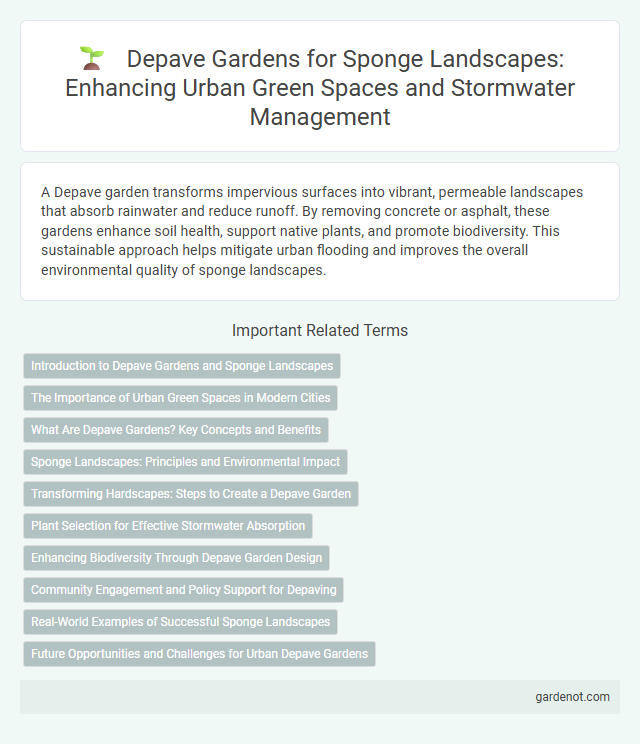A Depave garden transforms impervious surfaces into vibrant, permeable landscapes that absorb rainwater and reduce runoff. By removing concrete or asphalt, these gardens enhance soil health, support native plants, and promote biodiversity. This sustainable approach helps mitigate urban flooding and improves the overall environmental quality of sponge landscapes.
Introduction to Depave Gardens and Sponge Landscapes
Depave gardens transform impervious surfaces like parking lots into permeable green spaces that reduce stormwater runoff and improve urban water absorption. Sponge landscapes integrate depave gardens by using porous soils, native plants, and rainwater harvesting techniques to enhance groundwater recharge and mitigate flooding. These sustainable designs support biodiversity and help cities adapt to climate change by managing water more effectively.
The Importance of Urban Green Spaces in Modern Cities
Urban green spaces like depave gardens play a crucial role in mitigating heat islands and improving air quality in modern cities. These areas enhance biodiversity by providing habitats for native plants and pollinators while promoting stormwater absorption to reduce flooding risks. Investing in green infrastructure supports public health by encouraging outdoor activities and reducing urban stress.
What Are Depave Gardens? Key Concepts and Benefits
Depave gardens replace impermeable pavement with permeable soil and vegetation, enhancing urban stormwater management by reducing runoff and promoting groundwater recharge. These gardens mitigate flooding, improve water quality by filtering pollutants, and increase urban biodiversity by creating green habitats. Implementing depave gardens supports sustainable urban development and climate resilience through natural water absorption and habitat restoration.
Sponge Landscapes: Principles and Environmental Impact
Depave gardens exemplify sponge landscapes by replacing impervious surfaces with permeable soils and vegetation, enhancing stormwater infiltration and reducing urban runoff. These designs utilize principles of water retention, soil restoration, and native plant integration to mimic natural hydrological cycles. The environmental impact includes decreased flood risk, improved groundwater recharge, and increased biodiversity in urban areas.
Transforming Hardscapes: Steps to Create a Depave Garden
Transforming hardscapes into a depave garden involves removing impermeable surfaces like asphalt or concrete to restore natural soil permeability and enhance stormwater absorption. Key steps include assessing the area for drainage patterns, selecting native plants suited for the local climate, and sustainably disposing of removed materials to reduce environmental impact. Incorporating porous amendments and creating rain gardens helps improve biodiversity while mitigating urban runoff and heat island effects.
Plant Selection for Effective Stormwater Absorption
Choosing deep-rooted native plants such as prairie grasses, sedges, and wildflowers enhances stormwater absorption in Depave gardens by increasing soil permeability and stability. Incorporating a diverse mix of species with varying root depths promotes efficient water infiltration and reduces runoff, critical for urban sponge landscapes. Prioritizing drought-tolerant and moisture-loving plants ensures resilience and sustained performance during fluctuating storm events.
Enhancing Biodiversity Through Depave Garden Design
Depave garden design transforms impermeable surfaces into thriving ecosystems, significantly enhancing urban biodiversity by creating habitats for pollinators, birds, and beneficial insects. Incorporating native plant species and porous materials fosters soil health and water infiltration, promoting ecological resilience. This approach supports sustainable urban landscapes and increases local wildlife diversity, aligning with sponge landscape principles.
Community Engagement and Policy Support for Depaving
Depave gardens transform impervious urban surfaces into vibrant green spaces, fostering community engagement through volunteer-driven depaving events and educational workshops. These initiatives encourage local residents to actively participate in environmental restoration, promoting awareness of stormwater management and urban heat island mitigation. Policy support from municipalities, such as grants and zoning incentives, enhances the scalability of depaving projects, integrating sustainable green infrastructure into broader urban planning frameworks.
Real-World Examples of Successful Sponge Landscapes
The Depave garden in Portland, Oregon, exemplifies a successful sponge landscape by transforming a parking lot into a permeable green space that captures stormwater and reduces runoff. This project restored natural hydrology, improved urban biodiversity, and demonstrated significant reductions in local flooding. Other notable sponge landscapes, like the Green Alley in Chicago, also showcase how permeable pavements and rain gardens effectively manage stormwater in dense urban environments.
Future Opportunities and Challenges for Urban Depave Gardens
Urban depave gardens offer future opportunities for increasing green infrastructure, enhancing stormwater management, and improving urban biodiversity while mitigating heat island effects. Challenges include securing long-term funding, addressing soil contamination, and integrating depave projects within existing urban planning frameworks. Technological advances in permeable materials and community engagement strategies will be critical to overcoming these obstacles and scaling impact.
Depave garden Infographic

 gardenot.com
gardenot.com